Strings of pearls are seen to be a very complicated plant to grow. People oftentimes relate to the many difficulties they encounter in growing them without concentrating on the best practices to adopt in growing them.
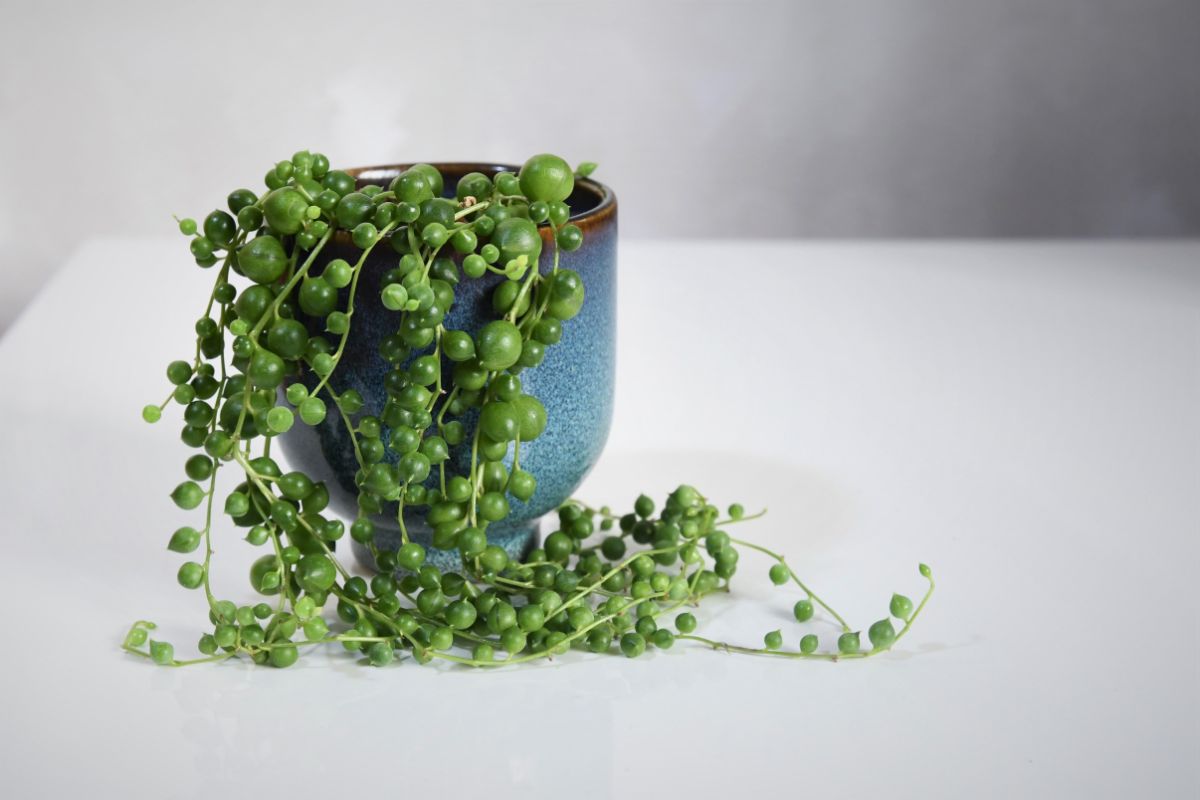
One thing, though, that is beyond our control when it comes to growing this plant is the detection of a good seed. That fact remains uncertain till you plant it.
Asides from that, following an accurate and comprehensive string of pearls growing guide, will see the plant grow without hitches.
In this article, we will be leaving no stone unturned as we discuss crucial aspects of the strings of pearl growth. But first, let's see some important details about it.
Jump to:
- Important Facts About String of Pearls Plant
- String Of Pearls Growing Guide
- Soil Requirements
- Light Requirements
- Watering Needs
- Fertilizer Application
- Temperature Requirements & the right humidity level
- Pruning Methods
- Potting & Repotting techniques
- Frequently Asked Questions
- Common pests that attack the string of pearls plant
- Conclusion
Important Facts About String of Pearls Plant
| Botanical Name | Previously known as Scenacio rowleyanus. Now called; Curio rowleyanus. |
| Common Names | String of bees, string of peas, rosary vine, string of pearls. |
| Plant Family | Asteraceae |
| Native Area | Africa |
| Plant Type | Soft & Succulent |
| Mature Size | 1 - 2 feet tall, 1 - 2 feet long |
| Sun Exposure | Full or partial Sunlight |
| Soil Type | Well-drained Sandy soil |
| Soil PH | Neutral to acidic |
| Bloom Time | Summer |
| Flower Colour | White |
| Hardiness Zone | 9 - 12 USDA |
| Toxicity | Toxic to humans and to pet animals |
String Of Pearls Growing Guide
Following the right growth and care guide for your plant determines its longevity. A properly grown string of pearl plants can stay around for about 5 years and even more if the stems are propagated.
Let's see below some of the core areas you should pay attention to when growing.
Soil Requirements
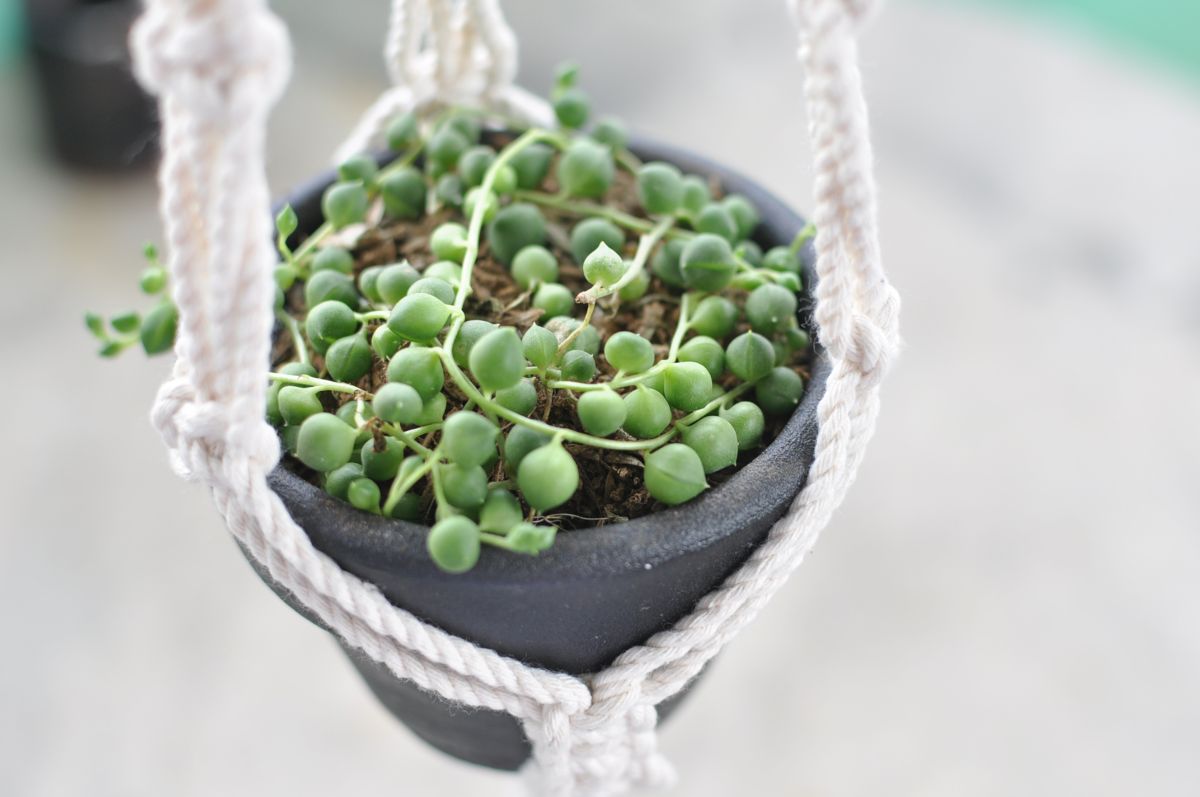
To be on the safe side, make use of sandy soil, even though it will still thrive in normal potting soils. Some gardeners make use of a mixture of potting soil and sharp sand using the 3-1 ratio.
However, one vital thing that you must ensure is that the soil must be well drained due to the tendency of the plant to have root rot.
To ensure well-drained soil, have the plants grown in a container with drainage holes fixed at strategic points (the base). A container that is capable of expunging excess moisture from the soil is exactly what you need.
Light Requirements
This is a significant aspect of the string of pearl growth. The plant needs a huge dose of sunlight as it grows in a specific combination, and seeing to this will enable your plant to grow well.
For the string of pearl plants, you'll need both direct and indirect sunlight for about 8 hours a day in the early mornings. When the sun is still mild, direct sunlight is preferred, but as it gets more intense in the afternoons, plants should be taken from under direct sunlight to a place where they can receive partial or indirect light.
Alternating the provision of light this way might be tasking, but the combination of direct and indirect sunlight is tested and trusted, say of the string of pearls growth.
Watering Needs

For best results, plants should be watered at least once in 2 weeks. Although, those grown in hotter regions or placed outdoors during summer might need to be watered more often than that.
A watering pattern should see that the soil stays slightly moist in its active growing time during spring and summer, then tone down the water supply during winter.
Watering should be done thoroughly and should conclude only when the water is seen to seep out of the drainage holes.
How do you know when your plant needs a drink?
Key indicators are the once succulent leaves going flat and extreme dryness of the soil.
Beware of overwatering the plant. String of pearls plants might be able to thrive even in drought but cannot tolerate soggy soil.
You can prevent overeating of the plant by checking first to see if about half an inch of the soil is dry before watering again.
Fertilizer Application
Fertilizer should be applied once in two weeks during the plant’s active growing season. During winter, when the plant goes dormant, apply sparingly once in about 5-6 weeks.
For best results, use water-based or balanced liquid fertilizer diluting it to half its strength before use in order for it not to overwhelm the plant.
Do note that the string of pearls does not really fancy over application of fertilizer as that can lead to the plant's death.
Temperature Requirements & the right humidity level
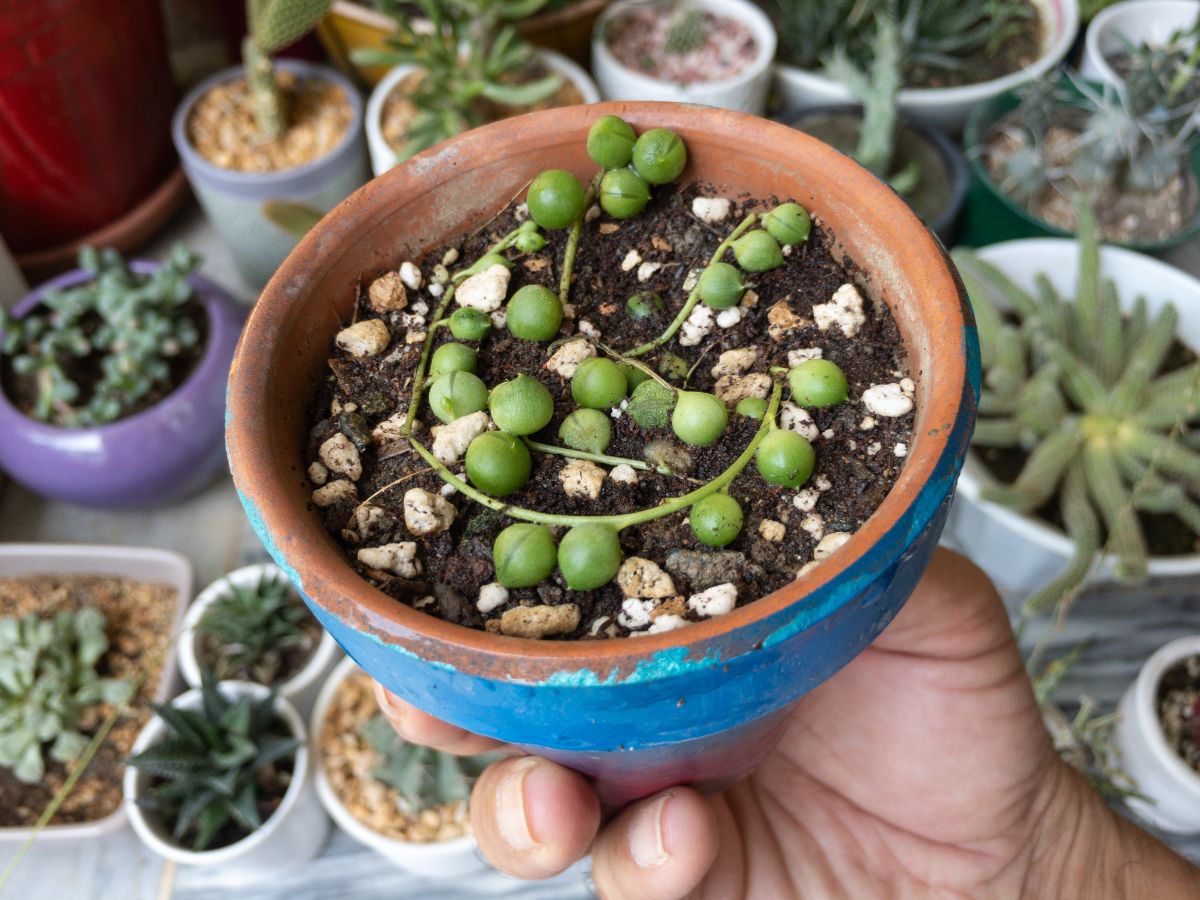
The string of pearl plants will grow at their best under warm temperatures.
From spring down to fall, temperatures above 70% F are more preferred. During winter, 55-60% F is best for the plant.
The plant also thrives best under low humidity levels. What this means is that spots that are naturally humid, like bathrooms and kitchens, are not places to keep them.
Pruning Methods
Dying stems, those that have lost so many leaves and withered pearls of the strings of pearl plant, must be pruned out.
Pruning the plant at the right time will keep it looking neat and tidy and encourage fuller growth.
If you notice your plant is getting too long, you can have the branches cut down and propagate new plants from the stem cuttings.
Pruning should be done using only well-sterilized pruning scissors to avoid contamination of the plant.
Potting & Repotting techniques
Repotting should be done before they die back, preferably at the beginning of spring, which is also the start of their growing season. The same soil standard that was used when planting must be maintained as well when repotting.
Pour in the soil into the pot, after which you can now carefully pull out the root ball from the previous pot and place it deeply rooted in the new pot in order to draw nutrients from the fresh soil.
Use a pot with effective drainage holes and put in non-soggy, succulent soil. The ideal pot should be the next size of the pot the plant is currently planted in.
Propagation methods of the strings of pearl plant:
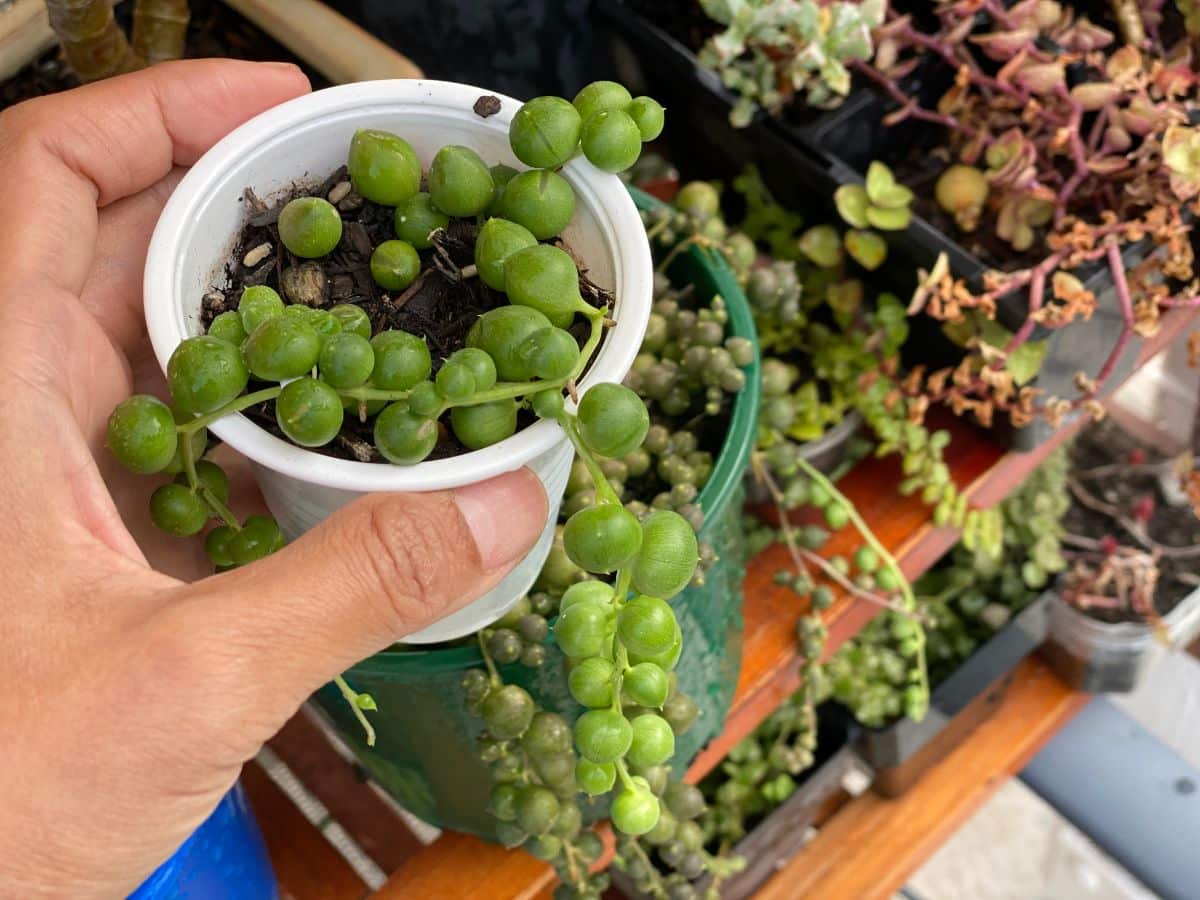
The main essence of propagation is to prolong the lifespan of your plant. It is best carried out in spring, summer, or early fall in very warm climates. The best propagation method for the strings of pearl plants is via stem cuttings.
Some people have seeds planted instead, but the results from using that method have been very unimpressive.
Stem cuttings can be obtained during pruning and used to grow new plants. Once done, the plants will begin to take root in a month at most.
Below is a step-by-step outline of how to grow new plants from stem cuttings.
Items needed for these ventures are
· Sterilized pruning scissors
· A 4/6 inch pot
· Cactus soil or other good succulent potting mix
Methods
- Have the stems cut about four inches underneath the leaf nodes. Take out the last two leaves. Place the leaves out to dry for a day or two before going ahead to plant.
- Get a pot and have it filled with soil just in the middle. Make a hole in which you are to place the plant.
- Have the cuttings placed an inch deep into the holes already made. See that the leaves stay above the soil and scrape out the dirt around the soil. Hold on for a few days before giving it an intense watering. Remember also to water anytime you notice the soil is dried.
- See to the light requirements of the plant. For an indoor plant, have them placed in a corner where they can get a good dose of sunlight. If planted outside, remember to give it partial/indirect sunlight.
Frequently Asked Questions
How to make string of pearls bloom
You can promote spring flowers by reducing watering and placing the plant in a spot where they can enjoy a consistent temperature of 65° in winter.
When they bloom, they spot very tiny whitish flowers that smell just like cinnamon.
Simply put, a dry but cool condition in winter would encourage full blooming in summer that will last for about a month.
Is the string of pearls toxic?
Behind the beauty of this enchanting succulent is a sap that has been proven to be toxic to both humans and pets.
When consumed, side effects like rashes, itching, or other forms of skin irritation have been recorded. In others, vomiting and other gastrointestinal symptoms have also been noticed.
Some of this discomfort can be noticed when an animal consumes it too.
This is why it is advised that you put a can on gloves when pruning or touching the plant and keep it out of the reach of children and pets.
Common pests that attack the string of pearls plant
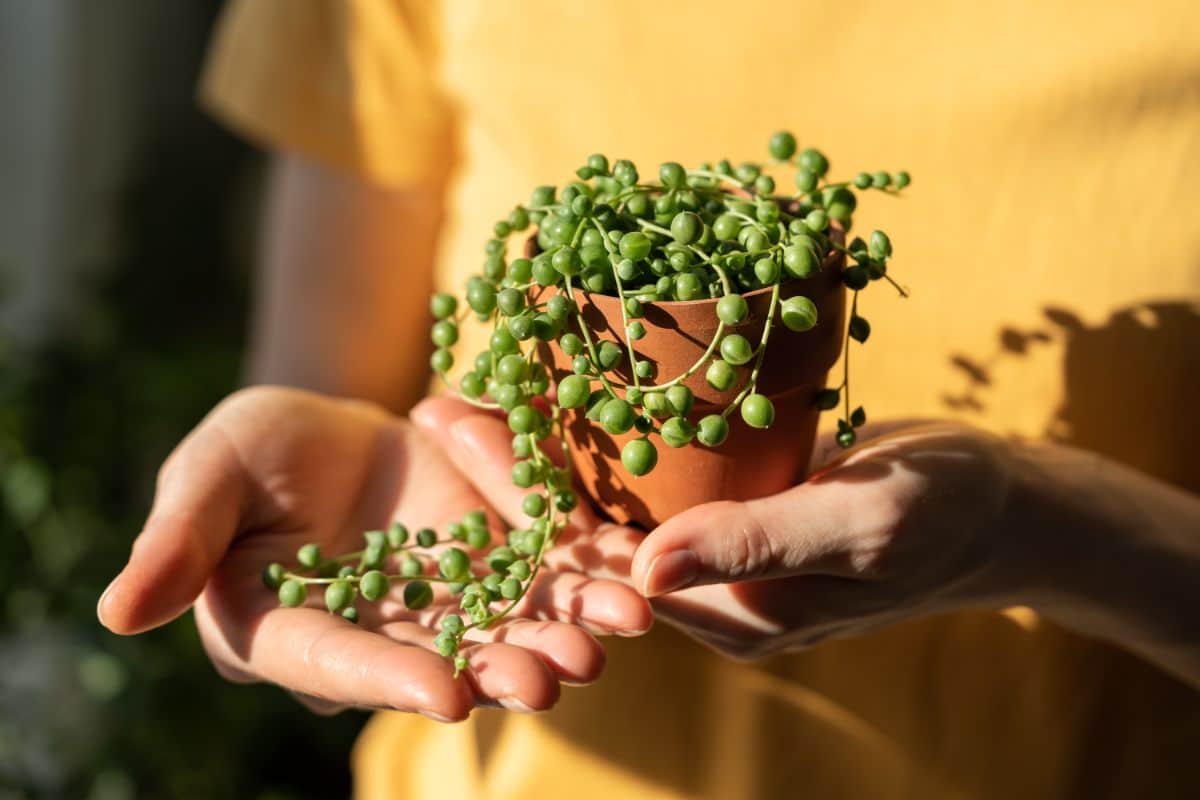
They include whiteflies, mites, aphids, ants, etc. Boost plants immunity by providing its basic growth requirements.
Conclusion
The string of pearls plant is a beautiful-looking plant that is sure to brighten your space. Just like its name - strings of pearl, it has a string of advantages that should make you eager to grow them.
To start with, they are fast-growing plants; they propagate easily due to their shallow roots; they also grow new roots easily and are very versatile. You can have them grown as indoor or outdoor plants.
Knowing how to properly grow and care for your plant would see them staying around for years.




